ISTQB CTFL Automotive Software Tester
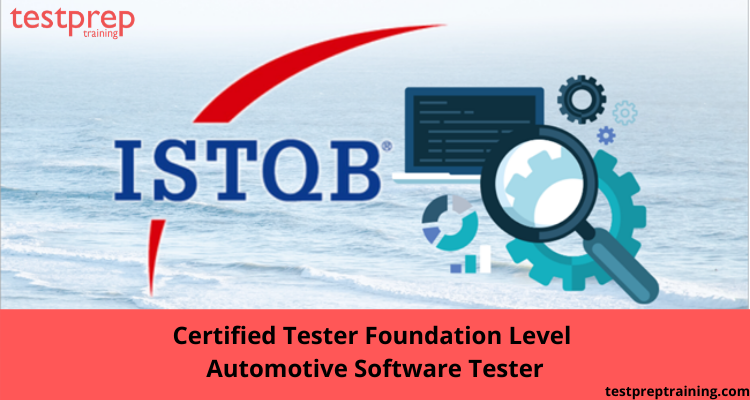
The ISTQB CTFL Automotive Software Tester certification validates the skills of the professionals who are working within automotive projects. This certification is also beneficial for the ones who are planning to start the implementation of special automotive testing techniques in the near future. The certification trains you in Automotive activities, roles, techniques, and methodologies specific to the role of an Automotive Software Tester.
Intended Audience
- Professionals having an in-depth testing experience in the various traditional methods
- Junior professional testers having Foundation Level certificate and want to grab a firm command of tester’s role in automotive projects
- Professionals with relatively less experience in testing and wish to learn about the implementation of test approaches, methods, and techniques in automotive projects
- Experienced Professionals who want to enhance their expertise in performing and managing to test on all levels in
automotive projects
The aforementioned professionals here are the ones performing roles of testers, test analysts, test engineers, test consultants, test managers, user acceptance testers, and also software developers. The certification is ideal for professionals such as project managers, quality managers, software development managers, business analysts, IT directors, and also, management consultants.
ISTQB Automotive Software Tester Interview Questions
Business Outcomes
Candidates taking the CTFL Automotive Software Tester Specialist syllabus exam will gain expertise in accomplishing the following Business Objectives:
- You will be able to collaborate effectively in a test team
- You will become capable of adapting the test techniques according to the specific automotive project requirements
- Moreover, you’ll become capable of selecting suitable test techniques, considering the requirements of the relevant automotive standards
- Finally, you will learn the application of virtual test methods (e.g. HiL, SiL, MiL, etc.) in different test environments
Exam Details
The ISTQB Automotive Tester Questions are in Multiple Choice Format. You get 60 minutes to complete the 40 questions of this exam. Moreover, the exam will cost you $260 USD. Also the ISTQB Foundation Level Automotive Tester Exam passing score if 65% and above.
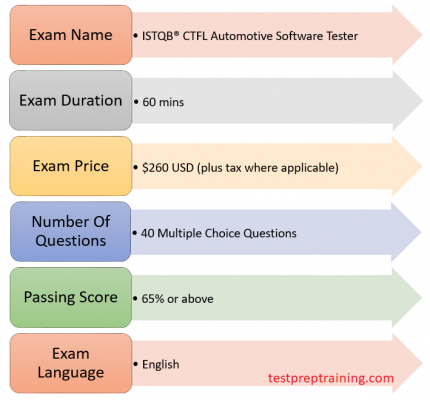
Exam Prerequisites
Candidates taking the CTFL Automotive Software Tester Specialist Certification Exam must posses the following prerequisites –
- Candidates must have prior experience in software-based systems
- Also, Candidates must have in-depth knowledge of software and/or systems testing or in software/systems development
For More Details See – ISTQB CTFL Automotive Software Tester FAQ
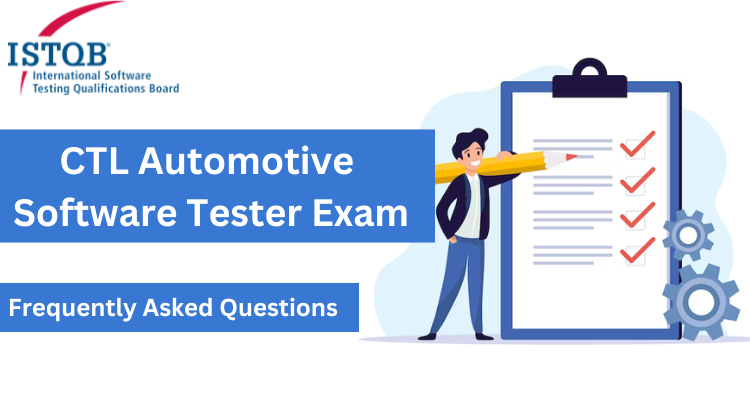
Course Outline
The course outline forms the most important part for your exam preparations. All ISTQB Foundation Level Automotive Tester Exam Question originate from the course, It covers descriptive details about the exam domains:
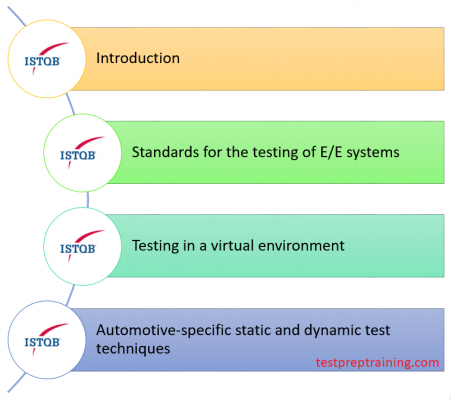
Module 1 – Introduction
1.1 Requirements from divergent project objectives and increasing product complexity
1.2 Project aspects influenced by standards
1.3 The six generic phases in the system lifecycle
1.4 The contribution/participation of the tester in the release process
Module 2 – Standards for the testing of E/E systems
2.1 Automotive SPICE (ASPICE)
2.2 ISO 26262
2.3 AUTOSAR
2.4 Comparison
Module 3 – Testing in a virtual environment
3.1 Test environment in general
3.2 Testing in XiL test environments
Module 4 – Automotive-specific static and dynamic test techniques
4.1 Static test techniques
4.2 Dynamic test techniques
ISTQB CTFL Automotive Software Tester Reference
ISTQB CTFL Automotive Software Tester Preparation Guide
The ISTQB Foundation Level Automotive Tester Study Guide will set you on the right track by providing you access to the best resources. Lets get started:
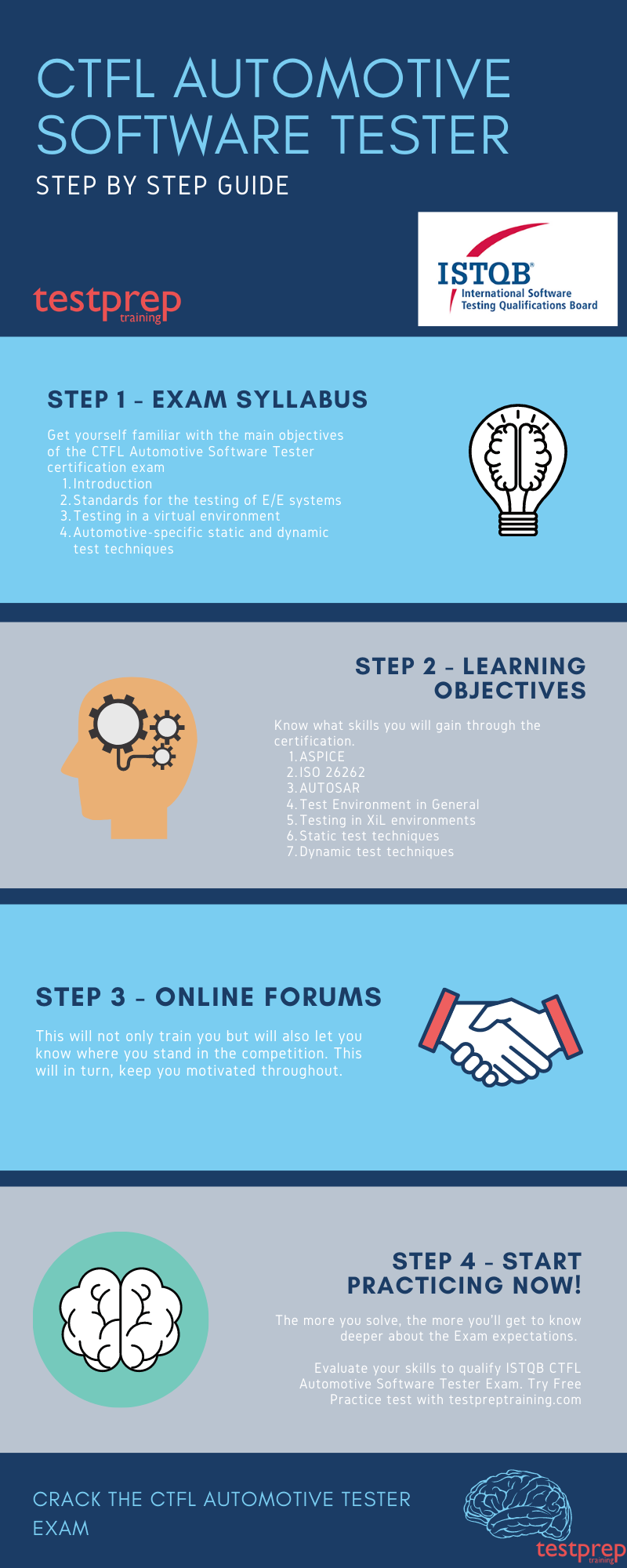
Exam Syllabus
Before heading towards your preparation journey, you must get yourself familiar with the main objectives of the CTFL Automotive Software Tester certification exam. ISTQB provides the candidates taking it’s certification, with a well-structured ISTQB Automotive Tester Syllabus. Knowing the exam objectives is very important to get an insight into the exam. So visit the Official website of ISTQB, to have a clearer view of the exam guide. A thorough analysis of the exam guide will let you align yourself more deeply with the chief objectives if the exam. And hence, enabling you to gain the required command to earn your desired certification.
Learning Objectives
The CTFL Automotive Software Tester Specialist Certification will demonstrate candidate’s skills in the following areas –
Introduction
The tester must be able to –
- Explain and give examples of the challenges of automotive product development that arise from divergent project objectives and increasing product complexity.
- Recall project aspects that are influenced by standards such as time, cost, quality, and project/product risks.
- Recall the six generic phases in the system life cycle per ISO/IEC 24748-1
- Recall the contribution and the collaboration of the tester in the release process.
ASPICE
The tester should be able to –
- Recall the two dimensions of Automotive SPICE (ASPICE).
- Explain the Capability levels 0 to 3 of ASPICE.
- Explain the meaning of the 4 rating levels and the capability indicators of ASPICE from the test perspective.
- Explain the requirements of ASPICE for the test strategy including the regression test strategy.
- Recall the requirements of ASPICE for the test documentation.
- Design a verification strategy (in contrast to a test strategy) and criteria for unit verification.
- Explain the different traceability requirements of ASPICE from the test perspective.
ISO 26262
The tester should be able to –
- Explain the objective of functional safety for E/E systems.
- Recall his contribution as a tester for the safety culture.
- Present the role of the tester in the framework of the safety life cycle per ISO 26262.
- Recall the volumes (part titles) of ISO 26262 that are relevant for him.
- Recall the criticality levels of ASIL.
- Explain the influence of ASIL on applicable test design techniques and test types for static and dynamic tests and the resulting test extent.
- Apply the selected method table of the ISO 26262.
AUTOSAR
The tester should be able to –
- Recall the objectives of AUTOSAR.
- Recall the influences of AUTOSAR on the work of the tester.
Comparison
The tester should be able to –
- Recall the different objectives of ASPICE and ISO 26262.
- Explain the differences between ASPICE, ISO 26262 and CTFL regarding the test levels.
Test Environment in General
The tester should be able to –
- Recall the purpose/the motivation of a test environment in the automotive environment.
- Recall the general parts of an automotive-specific test environment.
- Recall the differences between Closed-Loop systems and Open-Loop systems.
- Recall the essential functions, databases, and protocols of an electronic control unit (ECU).
Testing in XiL environments
The tester should be able to –
- Recall the structure of a MiL test environment.
- Explain the application area and the boundary conditions of a MiL test environment.
- Reproduce the structure of a SiL test environment.
- Recall the structure of an HiL test environment.
- Explain the application areas and the boundary conditions of an HiL test environment
- Summarize the advantages and disadvantages of the testing with the help of the criteria of the XiL test environments (MiL, SiL, and HiL)
- Apply criteria for the assignment of a given test scope to one or more test environments
- Classify the three XiL test environments (MiL, SiL, HiL) in the V-model
Static test techniques
The tester should be able to –
- Explain the purpose, the types, and obligations of the MISRAC: 2012 programming guideline with the help of examples.
- Apply a review of requirements with the quality characteristics of the ISO/IEC 29148 that are relevant for him.
Dynamic test techniques
The tester should be able to –
- Create test cases to achieve modified condition/decision testing coverage.
- Explain the use of back-to-back testing by giving examples.
- Explain the principle of fault injection tests by giving examples.
- Recall the principles of requirement-based testing.
- Apply context-dependent criteria for the choice of suitable and necessary test design techniques.
Join Community/ Online Forum
A healthy discussion is always beneficial, no matter where it is done. The same goes for online discussion forums. This is a nice way for the students to discuss their issues and get insights into how their competitors are going for the exams. One thing which is an advantage for anything that comes online is the scope of people joining it. An offline discussion is restricted to a small number of people, whereas online platforms can reach a wider range. The prospects of getting resolutions to an issue increase steeply when a greater number of people are involved. Also, multiple viewpoints make the stuff more dynamic. These discussions make the studies more comprehensive. Introverts get a chance to express themselves, who might otherwise prefer staying out of discussions. Forums work really well to build a community that is essential for understanding others.
Evaluate your skills
While you prepare for the exam, a practice run or two can help you in more ways than you might expect. Taking a ISTQB Foundation Level Automotive Tester Practice Exam is a great way to diversify your study strategy and ensure the best possible results for the real thing. Analyzing your answers will help you identify the areas where you need to give special attention to, and will also let you know your alignment with the exam objectives. Start practicing for ISTQB CTFL Automotive Software Exam Now!

